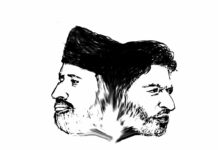Mehraj ud Din
 My journey of identifying Kashmir as one of the biggest occupied territories in the world is not different from how others identify it.
My journey of identifying Kashmir as one of the biggest occupied territories in the world is not different from how others identify it.
Rajbagh, one of the posh residential addresses in Srinagar, where I live is usually viewed as submissive or ‘coward’ area as it distances itself from the collective Azadi narrative.
Indian state never exonerated any section of the society on the basis of their collective attitude of co-operation. But that was hardly a criterion for Indian state to show leniency towards people of a particular place. They are as brutal in Rajbagh as elsewhere whenever they smell something fishy is going on.
In 2001, my acquaintance with Tabligh i Jamaat had an unparalleled effect on my conscious which turned me into a per-fervid worker of this mission.
My first encounter with Indian occupation in Kashmir came during my night stay with Tabligh i Jamat in our local mosque. It was around 3 AM when I was sleeping inside the mosque with other and was woken by a barrel pointed at my face. I shrieked in fear when I saw that mosque was filled with army men who were ordering everybody out.
We were lined up and one by one put in front of a gypsy for identification. While my turn was coming, a shiver scarred in my body. I had a strange feeling that I will be put into the gypsy and will never come back as I have heard tales of disappeared young people who never returned to their beloved homes. I was spared but now we were asked to stand in line and I thought we all will be shot dead. All of us were spared and they left taking one guy whose whereabouts are still unknown.
The curfew culture and unending fear-psychotic strategy didn’t kill us physically but turned us into coward mute-robots. The Kashmiri writer Agha Shahid Ali captured the essence of this period in these words:
“Srinagar hunches like a wild cat; lonely sentries, wretched in bunkers on the city’s bridges, far from their homes in the plains, licensed to kill … while the Jhelum [river] flows under them, sometimes with a dismembered body. On Zero Bridge the jeeps rush by … guns shoot stars into the night, the storm, rages on, night after night, son after son taken away, never to return from the night of torture.”
The resistance of Kashmir developed in different contexts with different manifestations contoured diverse narratives. The unending pain and agony shivered our existence and we were doing every bit to remain apolitical but on the other side every drop of tear and blood was turning us into a courageous nation.
Unlike their previous generation, who picked up the AK-47, this generation’s weapon of choice is the stone, social media and now academic rebuttal but the sense of grievance is equally intense. Anger towards Indian authority is deeply rooted in the Kashmir valley, the credibility of Pakistan is rationally all-time low but emotionally high among the population. The dilemma and ambiguity has become a household phenomenon in Kashmir’s dream for freedom. We are dwindling between the rim and axis of India, Pakistan and resistance groups due to the political paradigm shifts from one solution to another.
Agha Shahid Ali expressed a hope for genuine peace in Kashmir:
“We shall meet again, in Srinagar, by the gates of the villa of peace, our hands blossoming into fists, till the soldiers return the keys and disappear.”
The people of the Kashmir Valley know that their fate is not in their hands; it is in the hands of those who wield power in New Delhi, in Rawalpindi and resistance ideologues. Yet the sense of powerless born of this realization is suffused with an enduring streak of defiance – a defiance fed by decades of suffering, trauma and tragedy.
Author is a doctoral candidate at Shah-i-Hamadan Insitute of Islamic Studies and can be mailed at [email protected]















